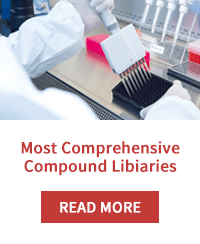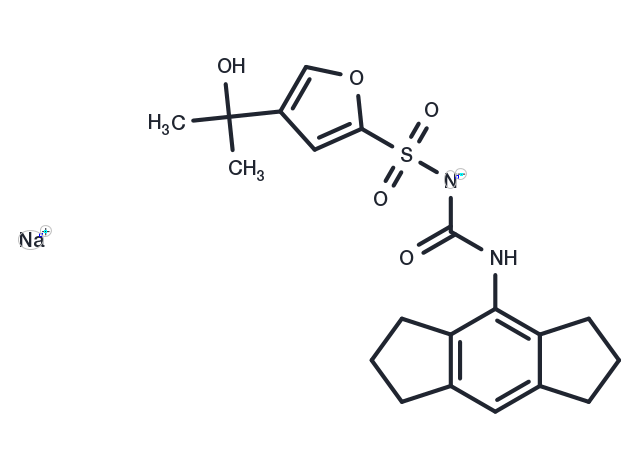Powder: -20°C for 3 years | In solvent: -80°C for 1 year


MCC950 sodium (CP-456773 sodium) is a potent and selective inhibitor of the inflammatory vesicle NLRP3 (IC50=7.5 nM in BMDMs; IC50=8.1 nM in HMDMs). MCC950 sodium has no effect on other inflammatory vesicles such as AIM2, NLRC4 or NLRP1.

| Pack Size | Availability | Price/USD | Quantity |
|---|---|---|---|
| 2 mg | In stock | $ 30.00 | |
| 5 mg | In stock | $ 47.00 | |
| 10 mg | In stock | $ 76.00 | |
| 25 mg | In stock | $ 159.00 | |
| 50 mg | In stock | $ 263.00 | |
| 100 mg | In stock | $ 409.00 | |
| 200 mg | In stock | $ 493.00 | |
| 500 mg | In stock | $ 790.00 | |
| 1 g | In stock | $ 1,120.00 | |
| 1 mL * 10 mM (in DMSO) | In stock | $ 52.00 |







| Description | MCC950 sodium (CP-456773 sodium) is a potent and selective inhibitor of the inflammatory vesicle NLRP3 (IC50=7.5 nM in BMDMs; IC50=8.1 nM in HMDMs). MCC950 sodium has no effect on other inflammatory vesicles such as AIM2, NLRC4 or NLRP1. |
| Targets&IC50 | NLRP3:7.5nM |
| In vitro |
METHODS: Mouse bone marrow-derived macrophages BMDM were stimulated with LPS (10 ng/mL) for 3 h, stimulated with MCC950 sodium (1-1000 nM) for 30 min, and then treated with ATP (5 mM) for 1 h. Levels of IL-1β and TNF-α were measured by ELISA. RESULTS: MCC950-treated cells dose-dependently inhibited the release of IL-1β in BMDM, and LPS-dependent TNF-α secretion was not impaired by MCC950. [1] MCC950 was used in the treatment of BMDM cells. METHODS: Mouse macrophages, human coronary artery endothelial cells and smooth muscle cells were treated with MCC950 sodium (0.02-20 μM) for 3 days, and cell viability was measured by Alamar Blue assay. RESULTS: MCC950 sodium had no toxic effect on the three cells. [2] |
| In vivo |
METHODS: To detect anti-NLRP3 activity in vivo, MCC950 sodium (20 mg/kg) was injected intraperitoneally into a mouse model of the human CAPS disease MWS once daily for four weeks. RESULTS: MCC950 rescued the CAPS mouse model and inhibited NLRP3 in human MWS cells. [1] METHODS: To investigate the pharmacological effects on experimental spinal cord injury models in vivo and neuronal injury in vitro, MCC950 sodium (10-50 mg/kg) was intraperitoneally injected into C57BL/6 mice with spinal cord injury (SCI). RESULTS: MCC950 improved grip strength, hindlimb movement, spinal cord edema, and pathological damage in SCI mice. It exerted this effect by blocking NLRP3 inflammatory vesicle assembly and the release of the pro-inflammatory cytokines TNF-α, IL-1β, and IL-18. [3] |
| Kinase Assay | kinase activity assays: All assays are carried out in 384-well white microtiter plates. Compounds are 4-fold serially diluted in 8 steps, starting from 10 μM. The reaction mixture consisted of 25 μL assay buffer (50 mM HEPES pH 7.5, 10 mM MgCl2, 5 mM MnCl2, 1 mM DTT, 0.1 mM Na3VO4, 5 mM β-glycerol phosphate). For FLT3 assays, the reaction contains 2.0 μg/mL FLT3 enzyme, 5 μM of poly(Glu,Tyr) substrate and 4 μM of ATP. For JAK1 assays, the reaction contains 2.5 μg/mL of JAK1 enzyme, 10 μM of poly(Glu,Ala,Tyr) substrate and 1.0 μM of ATP. For JAK2 assays, the reaction contained 0.35 μg/mL of JAK2 enzyme, 10 μM of poly (Glu,Ala,Tyr) substrate and 0.15 μM of ATP. For JAK3 assays, the reaction contained 3.5 μg/mL of JAK3 enzyme, 10 μM of poly (Glu,Ala,Tyr) substrate and 6.0 μM of ATP. For TYK2 assays, the reaction contained 2.5 μg/mL of TYK2 enzyme, 10 μM of poly (Glu,Ala,Tyr) substrate and 0.15 μM of ATP. The reaction is incubated at room temperature for 2 h prior to addition of 13 μL PKLight? detection reagent. After 10 min incubation luminescent signals are read on a multi-label plate reader. |
| Cell Research | MCC950 is dissolved in DMSO and stored, and then diluted with appropriate media before use[1]. BMDM are seeded at 5×105/mL or 1×106/mL, HMDM at 5×105/mL and PBMC at 2×106/mL or 5×106/mL in 96 well plates. The following day the overnight medium is replaced and cells are stimulated with 10 ng/mL LPS from Escherichia coli serotype EH100 (ra) TLRgrad for 3 h. Medium is removed and replaced with serum free medium (SFM) containing DMSO (1:1,000), MCC950 (0.001-10 μM), glyburide (200 μM), Parthenolide (10 μM) or Bayer cysteinyl leukotriene receptor antagonist 1-(5-carboxy-2{3-[4-(3-cyclohexylpropoxy)phenyl]propoxy}benzoyl)piperidine-4-carboxylic acid (40 μM) for 30 min. Cells are then stimulated with inflammasome activators: 5 mM adenosine 5'-triphosphate disodium salt hydrate (ATP) (1 h), 1 μg/mL Poly(deoxyadenylic-thymidylic) acid sodium salt (Poly dA:dT) transfected with Lipofectamine 200 (3-4 h), 200 μg/mL MSU (overnight) and 10 μM nigericin (1 h) or S. typhimurium UK-1 strain. Cells are also stimulated with 25 μg/mL Polyadenylic-polyuridylic acid (4 h). For non-canonical inflammasome activation cells are primed with 100 ng/mL Pam3CSK4 for 4 h, medium is removed and replaced with SFM containing DMSO or MCC950 and 2 μg/mL LPS is transfected using 0.25% FuGENE for 16 h. Supernatants are removed and analysed using ELISA kits. LDH release is measured using the CytoTox96 non-radioactive cytotoxicity assay[1]. |
| Animal Research | C57BL/6 mice were injected intraperitoneally with 50 mg/kg MCC950. |
| Synonyms | CRID3 sodium salt, CP-456773, CP-456773 sodium, MCC950 |
| Molecular Weight | 426.46 |
| Formula | C20H23N2O5S·Na |
| CAS No. | 256373-96-3 |
Powder: -20°C for 3 years | In solvent: -80°C for 1 year
H2O: 42.7 mg/mL (100 mM)
DMSO: 42.7 mg/mL (100 mM)
You can also refer to dose conversion for different animals. More
bottom
Please see Inhibitor Handling Instructions for more frequently ask questions. Topics include: how to prepare stock solutions, how to store products, and cautions on cell-based assays & animal experiments, etc.
MCC950 sodium 256373-96-3 Immunology/Inflammation NF-Κb NOD NOD-like Receptor (NLR) MCC 950 MCC-950 sodium inhibit CP456773 Inhibitor CRID3 sodium salt CRID3 CP-456773 CP-456773 sodium CP 456773 MCC-950 CRID 3 CRID3 sodium MCC950 CRID-3 inhibitor
